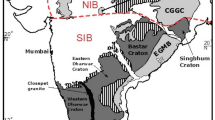Abstract
In the Precambrian Singhbhum stratigraphy, some enigmatic aspects exist as regards to Dangoaposi and Jagannathpur lavas. The existing enigma embodies locational aspects of these lavas, structural characteristics, stratigraphic position, and geochemical affinities. Based on recent field studies by the authors and knowledge acquired from existing literature, a possible solution has been proposed in the present study, which may be followed by Precambrian geologists in order to avoid all existing confusion and dilemma. The present study clearly indicates that in Jagannathpur, there is the presence of dyke rocks only (and there is no lava) and as such stratigraphic position of Jagannathpur lava in Singhbhum Geology should be discontinued. Dangoaposi lava (described as Jagannathpur lava by some previous workers) explicitly represents a portion of western Iron Ore Group (IOG) lava and therefore, may be considered to represent a sub-domain within western IOG.
Similar content being viewed by others
References
Alvi, S.H. and Raza, M. (1991) Nature and Magma Type of Jagannathpur Volcanics, Singhbhum, Eastern India. Jour. Geol. Soc. India, v.38, pp.524–531.
Banerjee, P.K. (1982) Stratigraphy, petrology and geochemistry of some Precambrian basic volcanic and associated rocks of Singhbhum district, Bihar and Mayurbhanj and Keonjhar districts, Orissa. Mem. Geol. Surv. India, v.111, 54p.
Bose, M.K. (2009) Precambrian mafic magmatism in the Singhbhum craton, eastern India. Jour. Geol. Soc. India., v.73, pp.13–35.
De, A. (1972) Structural features of the Deccan Trap tholeiites basalt flows of southern Kutch. Proc. Indian Sci. Congress, 56th Session. Part v.3, p.180.
De, A. (1974) Short and long distance correlation of the Deccan Trap lava flows. Bull. Geol. Min. Met. Soc. India (Abst), v.47, pp.50.
Dunn, J.D. (1940) The stratigraphy of south Singhbhum. Mem. Geol. Surv. India., v.63(3), pp.303–369.
Irvine, T.N. and Baragar, W.R.A. (1971) A guide to the chemical classification of the common volcanic rocks. Can. Jour. Earth Sci., v.8(5), pp.523–548.
Iyengar, S.V.P. and Murthy, Y.G.K. (1982) The evolution of the Archaean-Proterozoic crust in parts of Bihar and Orissa, eastern India. Rec. Geol. Surv. India, v. 112(3), pp.1–5.
Jelínek, E., Soucek, J., Bluck, B.J., Bowes, D.R. and Treloar, P.J. (1980) Nature and significance of beerbachites in the Ballantrae ophiolite, SW Scotland. Trans. Royal. Soc. Edinburgh: Earth Sci., v.71(3), pp.159–179.
Jensen, L.S. (1976) A new cation plot for classifying subalkalic volcanic rocks. Ont. Divs. Mines. Misc. Paper No. 66, 22p.
Jones, H.C. (1934) The iron ore deposits of Bihar and Orissa. Mem. Geol. Surv. India, v.63(2), pp.167–302.
Mahadevan, T.M. (2002) Geology of Bihar and Jharkhand. Geol. Soc. India, Bangalore, 563p.
Manikyamba, C., Ray, J., Ganguly, S., Singh, M.R., Santosh, M., Saha, A. and Satyanarayanan, M. (2015) Boninitic metavolcanic rocks and island arc tholeiites from the Older Metamorphic Group (OMG) of Singhbhum Craton, eastern India: Geochemical evidence for Archean subduction processes. Precambrian Res., v.271, pp.138–159.
Misra, S. (2006) Precambrian chronostratigraphic growth of Singhbhum-Orissa craton, Eastern Indian shield: an alternative model. Jour. Geol. Soc. India, v.67, pp.356–378.
Misra, S. and Johnson, P.T. (2005) Geochronological constraints on evolution of Singhbhum mobile belt and associated basic volcanics of eastern Indian shield. Gondwana Res., v.8(2), pp.129–142.
Mukherji, A., Chaudhuri, A.K. and Mamtani, M.A. (2004) Regional scale strain variations in Banded Iron Formations of Eastern India: results from anisotropy of magnetic susceptibility studies. Jour. Struct. Geol., v.26(12), pp.2175–2189.
Mukhopadhyay, D. (1988) Precambrian of the eastern Indian shield — perspective and prospect. Indian Jour. Earth Sci., v.3, pp.208–219.
Mukhopadhyay, D. and Matin, A. (2020) The Architecture and Evolution of the Singhbhum Craton. Episodes, v.43(1), pp.19–50.
Roy, A. and Sarkar, A. (2006) Geochronological constraints on evolution of Singhbhum mobile belt and associated basic volcanics of Eastern Indian shield-comment. Gondwana Res., v.9(4), pp.541–542.
Roy, H.P. (1969) A note on the occurrence of high-potash basalts in the lava flows south-west of Jagannathpur, district Singhbhum, Bihar. Bull. Geol. Soc. India, v.6, pp.28–30.
Saha, A.K. (1964) On the stratigraphic position of the basic lavas south of Jagannathpur. Bull. Geol. Soc. India, v.1, pp.2–6.
Saha, A.K. (1994) Crustal evolution of Singhbhum-North Orissa, Eastern India. Mem. Geol. Soc. India, v.27, 341p.
Saha, A.K., Ray, S.L. and Sarkar, S.N. (1988) Early history of the Earth: evidence from the Eastern Indian shield. In: D. Mukhopadhyay (Ed.), Precambrian of the Eastern Indian shield. Mem. Geol. Soc. India, no.8, pp.13–37.
Saha, D. and Mazumder, R. (2012) An overview of the Palaeoproterozoic geology of Peninsular India and key stratigraphic and tectonic issues. Geol. Soc. London, Spec. Publ., v.365(1), pp.5–29.
Sarkar, S.C. and Gupta, A. (2012) Crustal Evolution and Metallogeny in India. Cambridge University Press, Cambridge, 840p.
Sarkar, S.N. and Saha, A.K. (1977) The present status of the Precambrian stratigraphy, tectonics and geochronology of Singhbhum-Keonjhar-Mayurbhanj region, Eastern India. Indian Jour. Earth Sci., S. Ray Volume, pp.37–66.
Sarkar, S.N., Saha, A.K. and Miller, J.A. (1969) Geochronology of the Precambrian rocks of Singhbhum and adjacent regions, eastern India. Geol. Magz., v.106(1), pp.15–45.
Sengupta, S., Acharyya, S.K. and Deshmeth, J.B. (1997) Geochemistry of Archaean volcanic rocks from Iron Ore Supergroup, Singhbhum eastern India. Proc. Indian Acad. Sci. (Earth Planet. Sci.)., v.106(4), pp.327–342.
Streckeisen, A. (1976) To each plutonic rock its proper name. Earth Sci. Rev., v.12, pp.1–33.
Tomkeieff, S.I. (1940) The basalt lavas of the Giant’s Causeway District of Northern Ireland. Bull. Volcanol., v.6(1), pp.89–143.
Acknowledgments
This work is an output of collaborative research (supported by DST, New Delhi, Grant no. SR/S4/ES-510/2010) between the Department of Geology, University of Calcutta and National Geophysical Research Institute (NGRI), Hyderabad. CM thanks Dr. V.M. Tiwari, Director, CSIR, NGRI for his necessary kind permission to carry out this research. Authors are grateful to anonymous reviewer for providing very thoughtful and incisive comments.
Author information
Authors and Affiliations
Corresponding author
Rights and permissions
About this article
Cite this article
Ray, J., Maiti, S., Manikyamba, C. et al. Enigma of Dangoaposi and Jagannathpur Lavas of Singhbhum Craton, Eastern India: Possible Solution. J Geol Soc India 96, 356–362 (2020). https://doi.org/10.1007/s12594-020-1564-3
Received:
Accepted:
Published:
Issue Date:
DOI: https://doi.org/10.1007/s12594-020-1564-3




